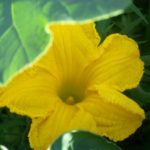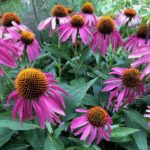
Happy Full Moon – May 16, 2022
This rhubarb post is part of my lunar blog series. Click here for more information on the full moon and new moon posts.
A Little about Rhubarb
Rhubarb is one of the earliest spring crops. It’s an easy to grow perennial and extremely hardy and cold tolerant, probably owing to its original home in Mongolia. Most people, if they know rhubarb at all, know it as pie. In fact, in the 1800s it was known as “pie plant”. Rhubarb’s tart flavor usually requires some sweetening and so it often ends up in deserts with lots of sugar. However, we can use it in any dish if we’re looking for a sweet/sour flavor. I’ve used it in both curries and stir fries. And there are many recipes for rhubarb chutney and relish.

It is also a beautiful plant. Garden books advise cutting off the flowers to help the plant send energy to the stalks, but I can’t do it. The flowers are elegant and huge, as are the leaves. If you’d like information on how to grow this great perrenial check out this Farmer’s Almanac post.
Healthy Stalks & Poisonous Leaves
It is common knowledge among gardeners that rhubarb leaves are poisonous. Only the leaf stalks are edible. I don’t even remember when I first heard or read this, but it turns out that it is a bit more nuanced than common knowledge lets on.
One of the energetic quailites of rhubarb is duality, and I think that quality sheds a light on this state of affairs. We sometimes think of duality as “one thing or the other” or “rhubarb stalks good – leaves bad”. But duality is not all about polar opposites; it is more of a continuum. There are grey areas and complexities in this story.

How Poisonous are the Leaves?
Awareness of rhubarb’s toxic nature began during WWI. Because of food shortages, people were encouraged to eat rhubarb which was plentiful. This increased consumption led to sickness and at least one documented death. Oxalic acid (or oxalate) is the substance that makes the leaves problematic. It can cause stomach distress and vomiting and can contribute to the formation of kidney stones. In high quantities it can be damaging to the kidneys and result in death.
Rhubarb leaves contain generous amounts of oxalate. But here’s the thing: oxalate is present in many other foods including the stalks that we eat, although in smaller quantities. Other foods with medium to high oxalate content include chard, spinach, beet greens, endive, cocoa powder, and nuts. In fact, spinach and chard are reported to have more oxalate than rhubarb, but we are encouraged to eat them. What do we make of that?
Most of us ingest some oxalates in our food everyday and handle it just fine. But eating large quantities of these foods (think many pounds) can cause problems. It is also a fact that individuals who are sensitive to oxalates cannot tolerate even small quantities. So the simple explanation of stalks are safe and leaves are toxic doesn’t hold for them. To use a garden analogy, it’s thornier. For more insight on the rhubarb conundrum check out Does Rhubarb Deserve Its Killer Reputation, by Rebecca Rupp

What Can Rhubarb Teach Us?
First of all, rhubarb reminds us that moderation in most things is a good practice. Secondly, it highlights the fact that life is often more complicated than assigning good/bad dichotomies to situations. For a mindful practice, we can challenge ourselves to look more deeply at long held assumptions in which we’ve assigned the polar opposites of good and bad. We can explore the nuances of scenarios instead of taking the easy way out in assigning right/wrong or good/bad. This takes some effort. Of course it is easier for our brains to group things into tidy categories. It saves time and energy. But what might we discover if we intentionally examine assumptions and our common understanding of the world over the next few weeks?



This is a great article, Joann. At a time when so much of the material we are exposed to in our culture and our media is obsessed with good and bad/us and them dichotomies, this is timely and right on.
Thanks so much Tracy! I know I need to focus on this more.